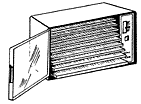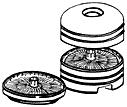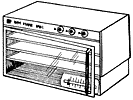Drying
Food dehydrators range in cost from $50 to $250; convection ovens that recommend drying range from $100 to $250; drying racks for convection ovens would be $15 to $50 extra.
 Food Dehydrator |
 Food Dehydrator |
 Convection Oven |
In general, safe drying temperatures for most vegetables and fruits are between 140° to 145° F. Even on rainy days when the relative humidity is 85 to 95 percent, it is better to dry in this temperature range than to raise the temperature. It is important that very high temperatures are not used to speed the drying process. Higher temperatures only serve to dry the outermost portion of the food while the interior remains moist resulting in what is called case hardening. Such foods will spoil due to microbial growth when the moisture from the interior migrates to the exterior of the product. In addition, higher temperatures speed up chemical reactions which deteriorate foods.
Do not attempt to dry food on rainy days when the relative humidity is high. The drying process will take much longer than on low humidity days. Humid air blown across the food contains more water vapor than dry air, so the humid air cannot hold as much of the water being removed from the food.
Size of Food Particles
The size of the pieces of food is another important factor influencing the rate of drying. Food should be cut into halves, strips, or slices and should not be more than 1/8- to ¼-inch thick. Larger pieces take longer to dry because it is more difficult for the water to travel through the pores in the food. In general a piece which is twice as thick as another one will take four times longer to dry. Thus, all pieces of food should be of uniform size and thickness. The pieces of food should be spread evenly on the dehydrator trays in thin layers and stirred occasionally. The trays should be rotated if top trays dry at different rates than the bottom trays.
The amount of food that should be dried at one time depends on the dehydrator. The manufacturer's direction book usually contains specifications about the amount of food that can be dried at one time. Some large dehydrators can hold up to 8 pounds of prepared produce. Portable convection ovens may hold only 2 to 3 pounds of prepared produce.
Do not keep adding fresh produce to the dehydrator as the food is drying. This common practice increases the time required to reach an acceptable degree of dryness and will produce a poor quality product.
A major problem in drying foods at home is determining if and when the food item is dry. In general, vegetables must be dried to about 5 percent water content and fruits to 15 to 20 percent water content. Dried fruits are stable at a higher moisture content than dried vegetables because the concentrated natural sugars and acids in the dried fruit function as preservatives.
To determine if vegetables are dry, remove some pieces near the end of the drying process. This time will usually be after a minimum of 6 to 8 hours. Cool the pieces to room temperature. The vegetable is dry if it is brittle or crisp when bitten, and if it will shatter when hit with a hammer.
Remove a piece of fruit during the end of the drying period. Cool to room temperature. It should feel pliable, leathery, and have no pockets of moisture.
Preliminary studies conducted at the University of Minnesota give some indication of the time and energy requirements for food dehydration. Drying time per load of fully loaded dryer ranged from 5 to 23 hours.
An average of 1 kWh of electricity was needed for drying each pound of fresh prepared produce. This energy cost is similar to the cost to freeze and store food in a freezer for 6 months. Freezer costs were based on 0.1 kWh per pound to freeze and 0.7 to 1.5 kWh* to store food for 6 months and assumes a full freezer.
The kWhs required to blanch and dry tomatoes were 1.324 kWh per pound. Zimmerman** reported the energy used in home canning tomatoes in a water bath canner to be 3.093 kWh for seven quarts which is 0.173 kWh per pound. A comparison of these figures indicates that home drying tomatoes used considerably more energy than processing them in a water bath canner.
| * | Based on range of operating cost of 15 cubic foot freezers as reported in the March 25, 1980, Federal Register. |
| ** | Zimmerman et al. "Home Canned Tomatoes: A Comparison of the Effects of Varying Time and Temperature Combinations During Processing." Home Economics Research Journal 7 (1978): 108-115. |
Dried foods must be stored properly to maintain the low moisture content and to prevent microbial deterioration. Before packing foods, the dried pieces should be allowed to cool for a short amount of time. Immediately after the product has cooled the food should be stored.
To store dried foods, place the dried food in plastic bags, press out air, seal or close, and then place in glass jars which are tightly sealed. Plastic containers or metal cans with plastic lids are not recommended because moisture can enter through the container. To be sure that the food remains dry, add dessicant or silica gel which you can purchase in the notions or housewares section of a department store or at hobby shops. Place the substance in the glass jar to cover the bottom of the container to a depth of ¼-inch thick.
The dessicant absorbs any moisture from the surroundings and prevents the food from absorbing moisture. Place the dried food wrapped in a sealed plastic bag over the dessicant and tightly seal the jar. Packaged dried food should be stored in a dry, cool, 60° F place. Dried food should also be kept out of the sun to prevent discoloration and nutrient loss.
Dried foods in sealed plastic bags may also be stored in the refrigerator or freezer.
The Icons below will guide you to the other Food Drying Pages |